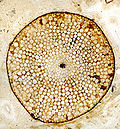Plant
A plant is a living thing that grow from the Earth. Most plants derive their energy from the Sun using a process called photosynthesis. Plants are characterized by their ability to produce their own food through the process of photosynthesis, which involves using sunlight, water, and carbon dioxide to produce organic compounds like glucose. They play a vital role in the ecosystem by producing oxygen and serving as the base of many food chains.
Anatomy[edit]
Plants have a complex anatomy that allows them to carry out photosynthesis and other essential functions. They typically have three main parts: roots, stems, and leaves. The roots anchor the plant in the soil and absorb water and nutrients from the ground. The stems provide support for the plant and transport water and nutrients from the roots to the leaves. The leaves are the primary site of photosynthesis and contain specialized structures called chloroplasts that are responsible for capturing sunlight. Plants also have specialized tissues that carry out specific functions. The xylem transports water and minerals from the roots to the rest of the plant, while the phloem transports organic compounds like glucose from the leaves to other parts of the plant.
Reproduction[edit]
Plants can reproduce sexually or asexually. Sexual reproduction involves the fusion of male and female gametes to form a zygote, which develops into a new plant. This process can occur within the same plant or between different plants. Asexual reproduction involves the production of offspring without the need for gamete fusion. This can occur through various mechanisms such as vegetative propagation, where a new plant grows from a fragment of the parent plant, or by producing specialized structures like bulbs or runners.
Diversity[edit]
There are over 300,000 species of plants, ranging from tiny mosses and ferns to towering trees. Plants are classified into various groups based on their characteristics such as the presence or absence of specialized tissues or the type of reproductive structures they produce. Some common groups of plants include angiosperms (flowering plants), gymnosperms (non-flowering seed plants), mosses, ferns, and algae. Each group has its own unique characteristics and plays a vital role in the ecosystem.
Importance[edit]
Plants are essential to life on Earth. They are the primary producers in most ecosystems, producing organic compounds that serve as food for other organisms. They also play a critical role in regulating the Earth's climate by absorbing carbon dioxide from the atmosphere and producing oxygen through photosynthesis. Plants have numerous other benefits as well. They are used in medicine to treat various ailments, and many plant compounds have been found to have anticancer and anti-inflammatory properties. Plants are also used in industry to produce a wide range of products such as lumber, paper, and textiles.
Threats[edit]
Plants face numerous threats, including habitat loss, pollution, climate change, and invasive species. Many plant species are endangered or threatened due to human activities like deforestation and urbanization. The loss of plant species can have cascading effects on the ecosystem, leading to declines in other species and a loss of ecosystem services.
References[edit]
See also[edit]
-
Plant
-
Plant
-
Plant
-
Plant
-
Plant
-
Plant
-
Plant
-
Plant
-
Plant
-
Plant
-
Plant
-
Plant
Ad. Transform your life with W8MD's Budget GLP-1 injections from $75


W8MD offers a medical weight loss program to lose weight in Philadelphia. Our physician-supervised medical weight loss provides:
- Weight loss injections in NYC (generic and brand names):
- Zepbound / Mounjaro, Wegovy / Ozempic, Saxenda
- Most insurances accepted or discounted self-pay rates. We will obtain insurance prior authorizations if needed.
- Generic GLP1 weight loss injections from $75 for the starting dose.
- Also offer prescription weight loss medications including Phentermine, Qsymia, Diethylpropion, Contrave etc.
NYC weight loss doctor appointmentsNYC weight loss doctor appointments
Start your NYC weight loss journey today at our NYC medical weight loss and Philadelphia medical weight loss clinics.
- Call 718-946-5500 to lose weight in NYC or for medical weight loss in Philadelphia 215-676-2334.
- Tags:NYC medical weight loss, Philadelphia lose weight Zepbound NYC, Budget GLP1 weight loss injections, Wegovy Philadelphia, Wegovy NYC, Philadelphia medical weight loss, Brookly weight loss and Wegovy NYC
|
WikiMD's Wellness Encyclopedia |
| Let Food Be Thy Medicine Medicine Thy Food - Hippocrates |
Medical Disclaimer: WikiMD is not a substitute for professional medical advice. The information on WikiMD is provided as an information resource only, may be incorrect, outdated or misleading, and is not to be used or relied on for any diagnostic or treatment purposes. Please consult your health care provider before making any healthcare decisions or for guidance about a specific medical condition. WikiMD expressly disclaims responsibility, and shall have no liability, for any damages, loss, injury, or liability whatsoever suffered as a result of your reliance on the information contained in this site. By visiting this site you agree to the foregoing terms and conditions, which may from time to time be changed or supplemented by WikiMD. If you do not agree to the foregoing terms and conditions, you should not enter or use this site. See full disclaimer.
Credits:Most images are courtesy of Wikimedia commons, and templates, categories Wikipedia, licensed under CC BY SA or similar.
Translate this page: - East Asian
中文,
日本,
한국어,
South Asian
हिन्दी,
தமிழ்,
తెలుగు,
Urdu,
ಕನ್ನಡ,
Southeast Asian
Indonesian,
Vietnamese,
Thai,
မြန်မာဘာသာ,
বাংলা
European
español,
Deutsch,
français,
Greek,
português do Brasil,
polski,
română,
русский,
Nederlands,
norsk,
svenska,
suomi,
Italian
Middle Eastern & African
عربى,
Turkish,
Persian,
Hebrew,
Afrikaans,
isiZulu,
Kiswahili,
Other
Bulgarian,
Hungarian,
Czech,
Swedish,
മലയാളം,
मराठी,
ਪੰਜਾਬੀ,
ગુજરાતી,
Portuguese,
Ukrainian











